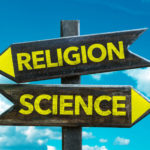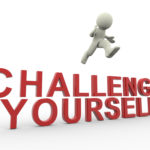Transcript download: science and Religion
“In this vlog I have been talking about how to use Buddhist philosophy and practice to deal with the concerns of everyday life. The longer I have been writing about this topic, the more curious I’ve become about what science has learned about how we humans create our reality since Nichiren Daishonin taught this form of Buddhism 750 years ago. In this vlog I want to discuss what science is teaching us and look at whether it supports our Buddhist practice.
There has been an argument between science and religion about what is most fundamental in the universe, consciousness or the quantum world. Eastern religions all say that there is a unified field at the basis of creation where we are all joined as one. Nichiren Buddhism describes it as the 9th level of conscious, the pure unsullied field. We all know that consciousness exists as we experience it every day.
The scientists go at the question in the reverse. They have reduced elements of the physical world to smaller and smaller levels until they have encountered the quantum field. That field contains multiple potentials at every minute. Some of them say that consciousness arises from this field,but some are starting to say that consciousness is an unmeasurable field underlying the quantum field.
Consciousness Starts the Process
Niels Bohr, physicist, and his colleagues in Copenhagen. developed the Copenhagen Interpretation which says, that nothing happens in the quantum field until it is observed. They say there is an observer: I think it is focused consciousness. Before an observation the object exists as a probability wave. But when it is observed it stops having infinite potential and sets, collapses into a solid object which can be located in a specific place and time.
Mark Vincente, one of the authors of What the Bleep do We Know?” says, “The observer is every human being, so every human being has the ability to observe and change subatomic reality.”
Best selling, award winning author, Lynne Taggart, writer of The Field, says this clearly. “Reality is unset Jell-O. There’s a big indeterminate sludge out there that’s our potential life. And we, by our very act of involvement, our act of noticing, our act of observation, we get that Jell-O to set. Our involvement creates that reality.”
John Wheeler, a Nobel Prize winner in physics from Princeton says, “The view can no longer be held that the world exists “out there’. We are not by standers on a cosmic stage but shapers and creators living in a participatory universe.”
The World Tribune, 11/21/2003: “Rather than there being one static environment that we living beings are born into, every environment is uniquely customized, tailored to suit each of us according to the state of our inner lives. So in a sense we are all going around with our personal
universe, one that extends from the inner depths of our hearts outward to all of the phenomena of our surroundings.”
President Ikeda, illustrates this scientific understanding in The Clear Mirror Guidance. “If you practice faith while doubting its effects, you will get results that are at best unsatisfactory. This is the reflection of your own weak faith on the mirror of the cosmos.
On the other hand, when you stand up with strong confidence, while controling your mind, which is at once both extremely subtle and solemnly profound, you should strive to elevate your faith with freshness and vigor. When you do, both your life and your surroundings will open wide before you and every action you take will become a source of benefit.”
Humanity is on the Verge of Understanding How We Create
What does this new scientific understanding mean for us? It means that humans as a species are coming to understand how we create our reality, the natural laws behind the act of manifesting something. I believe we are on the verge of taking our understanding and applying it
consciously and purposefully and not having what we create happen by accident. This can have enormous implications for our lives and our world.
It also brings spirituality back into the center of things as our spiritual core, as it is in that pure consciousness, where all creation begins.
Buddhism and Science
Part of why I am so fascinated by this is because Buddhism is reason and has been saying these things in its own way from the beginning. Our practice is an application of the principles we are now learning through scientific research.
Scientific evidence says that nothing happens in the quantum field until it is observed with intent. Buddhism teaches that we have to make a determination, a decision, when we are chanting about an issue.
Our practice says we receive back what we put out into the universe.
 Fred Alan Wolf, PHD – physicist, author of 12 books on the quantum field, says that action or thought arises in our consciousness. There is a certain frequency or vibration associated with that. By taking the action we are now connected to the universe by that frequency or vibration. Everything “out there” of the same frequency will respond to it, and then will be reflected in our reality. From What the Bleep pg 129. Other writers call this the Law of Attraction and see it as a natural law, like gravity. Buddhism would call it oneness of self and environment.
Fred Alan Wolf, PHD – physicist, author of 12 books on the quantum field, says that action or thought arises in our consciousness. There is a certain frequency or vibration associated with that. By taking the action we are now connected to the universe by that frequency or vibration. Everything “out there” of the same frequency will respond to it, and then will be reflected in our reality. From What the Bleep pg 129. Other writers call this the Law of Attraction and see it as a natural law, like gravity. Buddhism would call it oneness of self and environment.
Our practice says to set a goal and chant for that goal until it manifests. Fred Alan Wolf, PHD would say “Be willing to sit down every day and begin to observe, to design a new possible future for yourself – opportunities will begin to show up.” What the Bleep, pg 84.
Power of Thought
We know through our practice that if we doubt the outcome of a goal, a less satisfactory results are produced than if we positively envision that goal as already accomplished and stay positive.
Dr. Masaru Emoto, PhD did an experiment, subjecting water crystals to music from Beethoven to heavy metal, and photographing the results. In his books The Message of Water he shows pictures of how the music clearly affected the size and shape of the water crystals. He tried
another experiment with thoughts instead of music, and put signs on bottles of water, some of which were positive, “I love you”, some were negative “You make me sick, I will kill you.” The water with the beautiful messages formed beautiful crystals, the water with the negative
messages became ugly and malformed.
The experiment demonstrated that thoughts have power over matter. If thoughts affect water, how do you think thoughts can affect us or
influence the outcome of a goal?
What the scientists are discovering is making explicit what our practice teaches. Although it is inspiring we will also have a lot of work to do to learn to deal with the subtle beliefs and thoughts, which do not produce such good results. These are the subject for another vlog or book.
Summary:
Through modern day science we are coming to see the physical reality behind why our practice works. We are seeing how the quantum field, when observed, collapses into a concrete reality, so by our act of intention we create even in the physical world. We do this in our practice when
we set a determination.
We also discussed how mind can affect matter, leading us to think about the power of thoughts and how what we put out we receive back. This would illustrate the Buddhist concept of oneness of self and environment..
Alan Wolf Phd says that if we sit down everyday and visualize our day new opportunities will start to show up. Of course Nichiren Buddhism has a chanting practice which is done twice daily where we set goals and chant for their realization.
Other Readings/Vlogs you Might Like
If you are interested in this topic read What the Bleep Do We Know? (Discovering the Endless Possiblilities for Altering Your Everyday
Reality)
Beyond the Bleep. a follow up book, illuminates the personalities and teachings of the physicists, neurologists, physicians, spiritual teachers, mystics and scholars in the book and the movie What the Bleep Do we Know.
Do You Know How You Set Up Barriers to What You Want? https://wp.me/p3V1J9-XKChanting Difficulties? 4 Ways to Turn Things Around https://wp.me/p3V1J9-VN
Comments: I’m reflecting on what direction this vlog should take. I’d be very curious to know if this kind of topic is interesting and whether you would want to hear more about the intersection between science and religion. If not, tell me what other topics you’d like to hear about.





Margaret, thank you for your excellent vlog. You have helped me greatly.
Regarding science and religion, I would say a) science is fickle and b) is Buddhist practice representatively religious?
Science contains many factions and opinions. In that it does resemble “religion”! It has fads and fashions too. For over half a century, many scientists have questioned the Copenhagen Interpretation (see the work of Hugh Everett for example). It’s easy to get on the wrong side of science, and thus invite discredit. Though it is fun!
It is a lot of fun and there seems to be a big debate about the role of the observer. I think we are just beginning to learn about this.